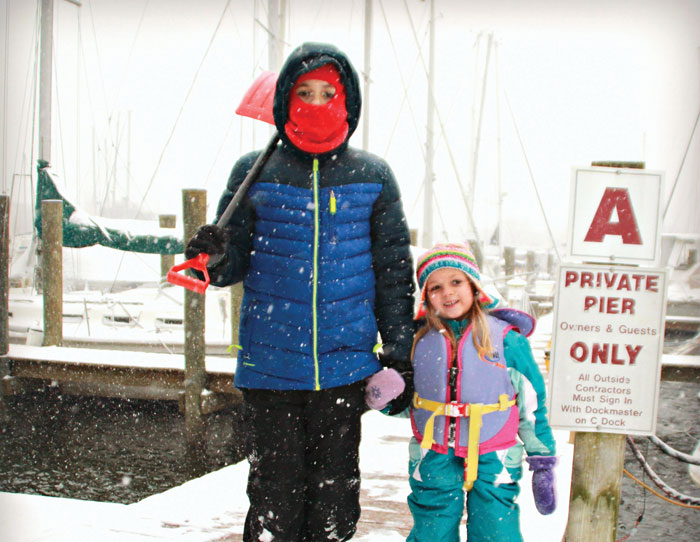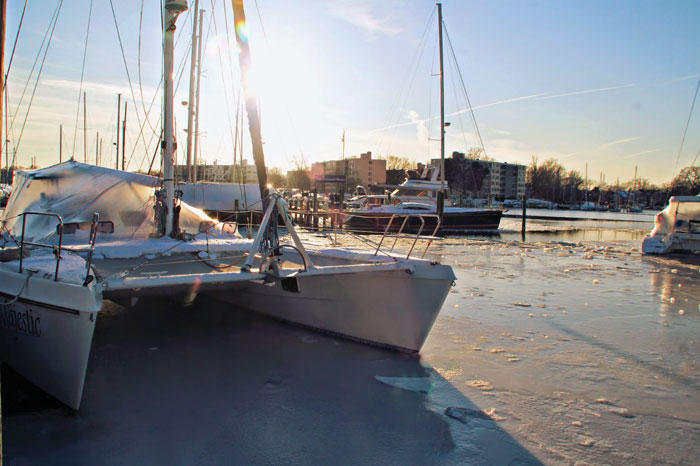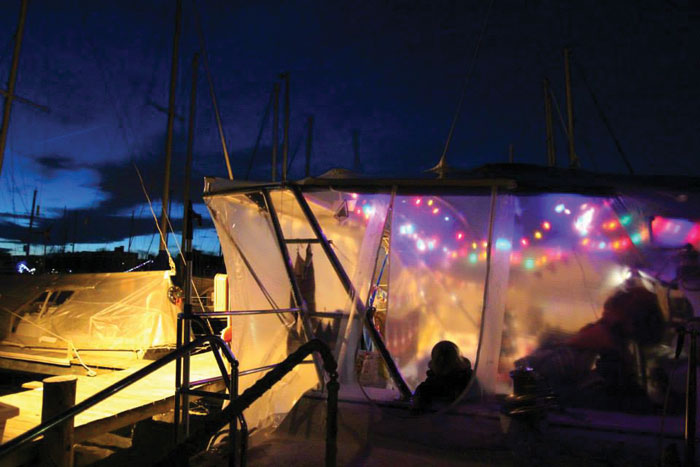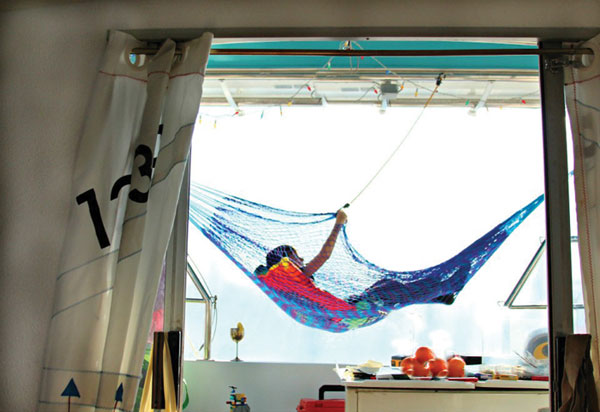A special kind of crazy
It takes a special kind of crazy to live aboard your sailboat in the winter time. My husband and I celebrated 20 years aboard this winter. We laugh now at how ill prepared we were that first winter aboard our first liveaboard sailboat. Back then we had a couple of heaters, the passion to try out a new lifestyle, and the warmth of youth and stupidity.
Looking back we did a lot of things wrong. We had no idea about condensation, and our clothes were soaked in our hanging lockers while our mattress mildewed from underneath. We had no idea how slippery the docks would get. We had no clue about balancing amps when plugging in heaters and other power sucking devices on the boat. One winter snow piled into our cockpit and blocked us from opening the companionway hatch. Another year so much snow piled onto the deck of our catamaran that the weight pushed our waterline down enough that water started coming into the boat.
The greenhouse effect
Now 20 years and 19 winters into it (we did manage to sail south and avoid one winter all together), we have learned a few tricks that make winter tolerable. It took us 15 years to try out shrink wrapping the boat for winter. Once we did it, we kicked ourselves and wondered why we hadn’t tried it earlier. It makes a huge difference in winter quality of life onboard. The bubble acts like a greenhouse when the sun is shining and traps warm, dry air all around the boat. When it snows, the snow slides off the shrink wrap, so no panic shoveling of the foredeck is required. If days are sunny, even if it’s frigid outside and windy, it often gets warm enough on our boat to just keep the heaters off all together during the day.
There are a few things we have learned about shrink wrapping over the years. You really need to ask for the clear wrap. If you live aboard and you wrap your boat in the solid white plastic, you will feel like a trapped animal and might chew your arm off by early February. Make sure you get an extra-large door, and get a spare door to keep onboard. You will want a nice big entry when getting on and off with groceries, pets, and kids. And usually the zipper on the door gives up mid-winter, so it’s nice to have a spare ready and waiting. The larger shrink wrap frame you create, the more space you have inside for projects. It’s a great way to do things like tackle deck leaks or re-bed hatches without worrying about weather.
However the way your shrink wrap bubble is attached to your boat matters. We had one business tape the bottom to our decks. It was lovely and air tight, but the tape they used left a horrid residue that was near impossible to get off come springtime. Other businesses will run a tension line along your deck and adhere the shrink wrap to that line. This solves the residue problem and keeps your decks clean, but it’s not as air tight. Whichever style you choose, definitely lay out the cash to get the pros to do it. We watched our industrious dock neighbors spend a pretty penny buying all the stuff needed to DIY the job; they took days and days to get it done. Ours was finished by the pros in two hours. Their DIY job came apart during the first strong nor’easter. Ours stayed tight and strong all winter.
Cooking
Even with shrink wrap, nights get cold aboard in winter. Sometimes whatever heating you have on board just doesn’t keep up. Meal planning can help with those frigid nights. This is the time of year to make pot roast, bake bread, boil lots of tea, and suddenly take up an interest in baking. It may not be the most efficient, but cooking onboard definitely warms up the cabin. Keep spare propane tanks filled and ready to go, because you will always run out of propane on the coldest, snowiest, darkest night when you are cooking and baking up a storm and expecting company.
Traditioal Christmas cookies are nice, but they are not the easliest thing to pull off in a boat oven. The small batches on the tiny cookie trays that fit most boat ovens tend to take forever, and for some reason the bottoms are alway burnt. Breads and muffins make a great holiday and winter baking project aboard a boat. Banana breads, zucchini breads, and muffins are always crowd pleasers and go well with warm drinks. They tend to cook up evenly in boat ovens, and they fill the cabin with warm, dry, delicious-smelling air. We also like to make chocoates for holiday gifting. A double boiler is easy enough to pull of on a boat stove, and melted dark chocoate can be made into peppermint bark, truffles, and chocolate-dipped anything. And if you're looking to spread holiday cheer, the easiest treats to whip up in a small galley are spiked drinks. Mulled wine, hot toddies, and spiked ciders make Santa and all his elves merry and bright.
And cuddling
We often end up sharing beds in winter with our kids and dog just for the body heat. We wear a lot of fleece and have a nice collection of wool socks and furry slippers. When that doesn’t work, we call our friends with big houses and fireplaces and offer to bring wine if they let us hang out on a cold night. We know now to insulate under our mattresses and in the hanging lockers to keep condensation at bay. We also keep certain hatches cracked open year round to keep air flow and also prevent condensation. We drink a lot of tea, use a lot of quilts, and eat a lot of banana bread.
Tips for no slips
Some must-have items for wintering aboard include slip prevention covers for the soles of your shoes. There are a few brands out there, but the idea is like chains on your tires when driving in the snow. You slip on these spiked or metal-coiled webs to the soles of your shoes, and it gives you grip when walking down a slippery dock. We consider these essential for everyone in the family.
Everyone has a good set of fleece pants, top, and socks. Keeping a small shovel onboard somewhere is a smart idea, and if you can a bucket of sand or salt on your pier. Of course carbon monoxide and smoke detectors are a must any time of year, but especially important in winter.
When all else fails, you can buy a plane ticket and book a charter somewhere warm. Frequent flier miles might be the best winterization tool of all.
by Cindy Wallach








